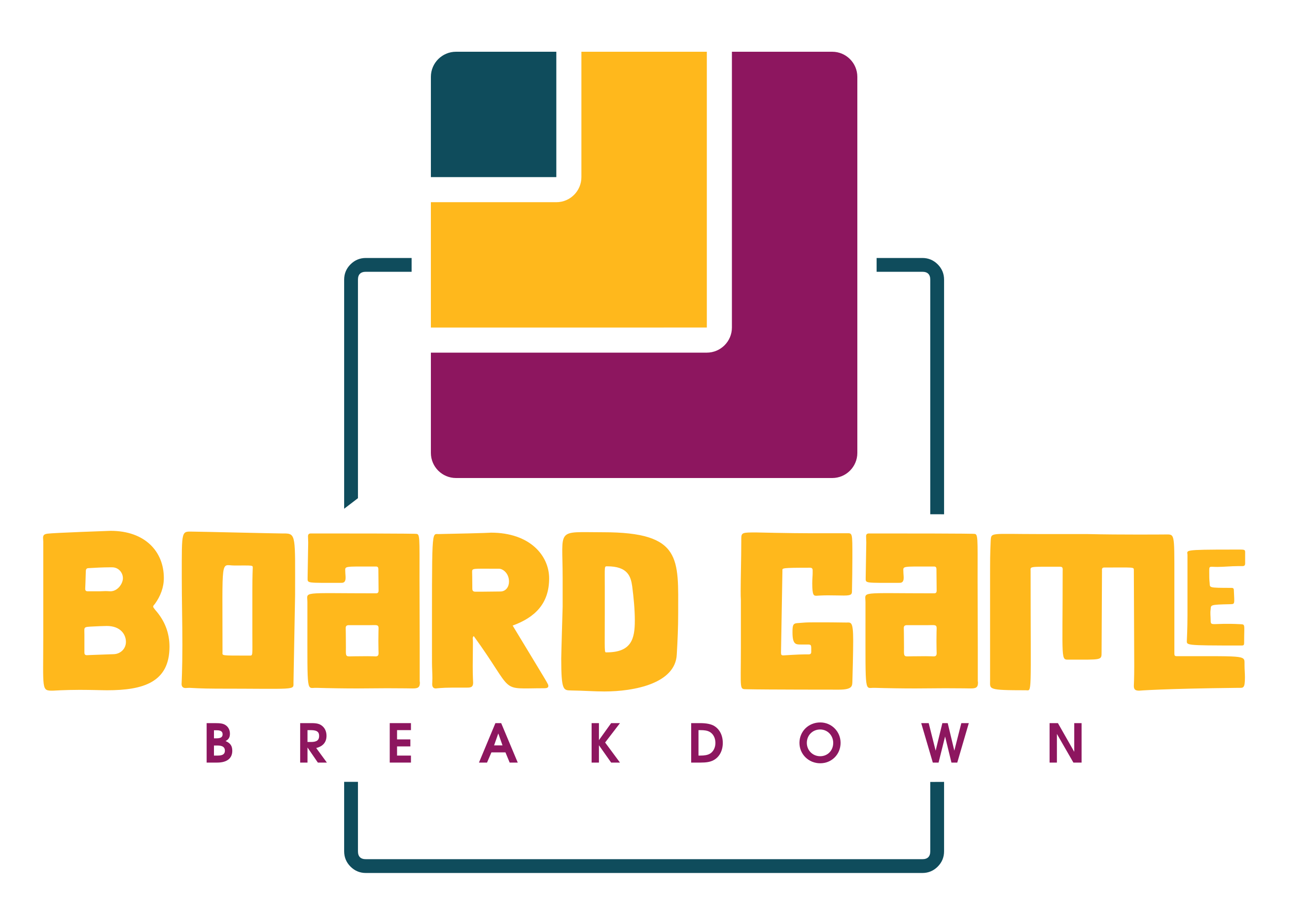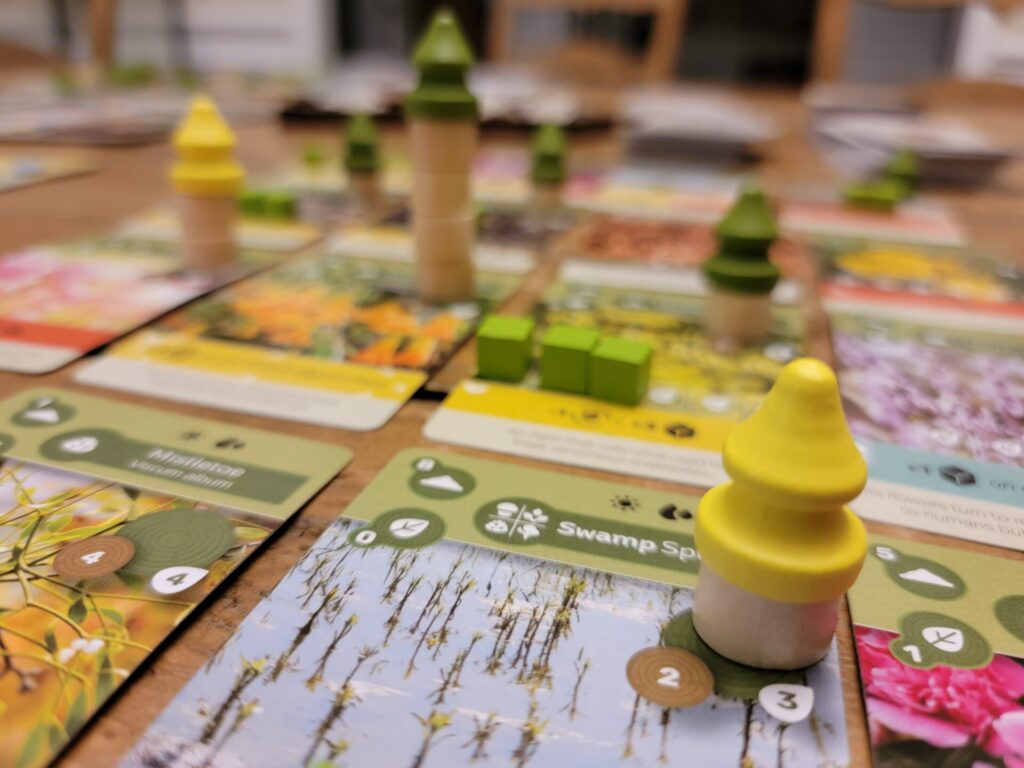
Name: Earth
Year of Release: 2023
Player Count: 1 – 5
Playing Time: 45 – 90 Minutes
Designer: Maxime Tardif
Publisher: Inside Up Games
Primary Mechanisms: Contracts, Hand Management, Pattern Building
Weight (According to BGG.com): 2.90
Overview
I was one of those 20-somethings who “breathed” music and in doing so, constantly thought what I listened to was inherently better than whatever you listened to. And I made sure to proudly (or so I thought) let you all know by only wearing shirts with these bands plastered across the front. Never mind that I bought most of these at Hot Topic, a store that you could find in any suburban mall across America in the early 00’s. In my mind, I was on the cusp of everything rad and new when it came to “underground” music.
Naturally, some of these bands were in fact, not all that well known so when people at work or college saw me they’d always ask some variation of, “oh your shirt says The Chariot on it, what kind of music is that?” I’d say some stupid genre name like, “post-hardcore” or “metal-core” and the inevitable response would be, “oh, metal, so like, Metallica?” And then I would do some cringe move where I’d try to explain why my brand of metal was better than your brand of metal. Yes, insufferable, I know but that’s how I was.
All of this is to explain that what I’ve learned is humans are just trying their hardest to relate to each other and a lot of times they do that by likening one thing to another, even if it’s not all that much similar. It’s just a way to connect to one another and try to make sense of something that they might not know about or understand. What the hell does any of this have to do with board games? Probably not a lot but I’m having flashbacks of this time after spending quite a bit of time with Earth.
Since 2023, I’ve looked at this game a hundred times, but it has always been compared to games I already have, namely Wingspan or Ark Nova. But after finally pulling the trigger and purchasing Earth, I can understand why people made these comparisons but I don’t know that they do the game a lot of justice. Read on to see why I think Earth definitely stands on it’s own and deserves a spot in your collection even if you don’t “need” another tableau builder.
Rulebook & Components
While I don’t believe a bad rulebook will “make or break” a board game, I do appreciate when a company takes the time to elevate a good rulebook to a great one and Earth has one of these rulebooks. Throughout the book, the designers have utilized both separate gray boxes and beige boxes to highlight certain elements. Gray boxes “indicate important details which should not be overlooked” and the beige boxes “indicate tips and options to make the game easier for new players.” I think it makes a huge difference, especially for players new to the modern board gaming landscape, when the rules have these important tidbits and a mechanism to make them really stand out.
Another really nice aspect is that on page nine of the book, there is a blurb letting readers know that they are 90% ready to play, with an additional reminder that they should read the iconography index at the bottom of the player boards. If they take this advice, they are 95% ready to play! I love the idea of this notification letting readers know that they can wait on the remainder of the rules and just go ahead and try the game. It saves the reader from possibly feeling too overwhelmed taking in a whole rulebook before playing. Bottom line: the rulebook is fantastic and will do a great job of clarifying the game for those playing it for the first time.
Moving to the components, let’s touch on one of the comparisons I mentioned earlier, and that is with Ark Nova. Earth comes jam-packed with cards and every single one of these cards is unique, just like in Ark Nova. Some of them, such as the Fauna, Ecosystem, Island, and Climate Cards are all double sided so they can act as two unique cards. Counting these unique faces as their own cards, the game ships with a total of 433 cards, and an additional six Solo Cards. Just like in Ark Nova, I don’t know that anyone needs this many cards in a practical sense, but it does make the players feel that they are getting a new experience every time they play.
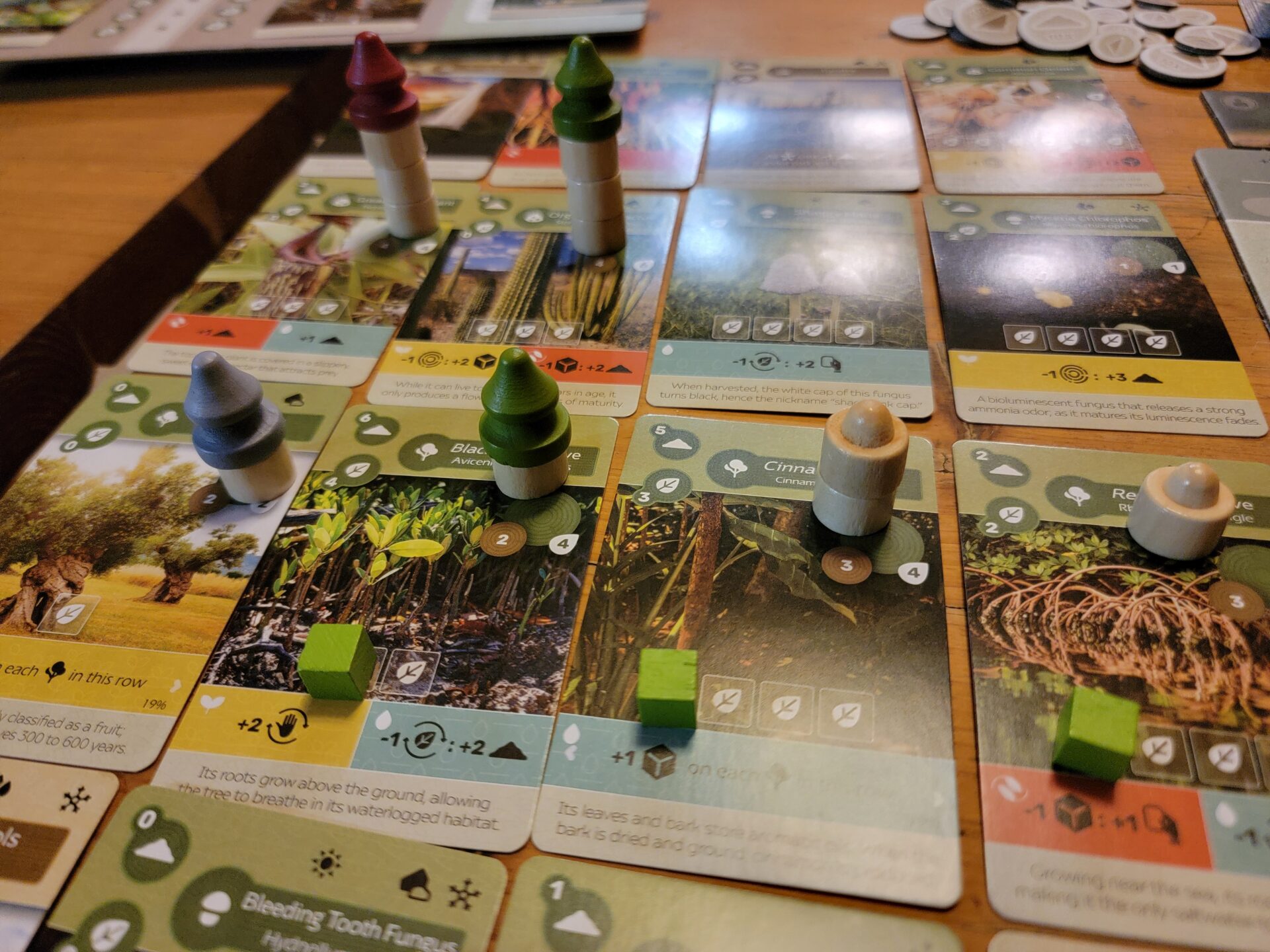
Another similarity to Ark Nova is that the cards utilize real-life nature photography for the card art. I think some people really hate this look but I adore it and I’m glad the designer made this choice. The cards are also emblazoned with an ability (or two) and the matching color, as well as some of the necessary iconography in the game. I applaud that the cards can end up conveying so much information with just a few symbols that are easy to interpret after only a play or two.
Outside of the cards, there are a few other components that will be utilized, namely being placed on various cards in your tableau. There are tiny green cubes known as Sprouts. There are cardboard chits representing Soil and Leaf Tokens. There are two kind of wooden pieces, the smaller Trunks and the larger Canopies, meant to allow players to stack a column of Trunks and then top them with a Canopy. Most of the time this works, though I have noticed some quality differences in the manufacturing of the Trunks, causing some of them to lean slightly akilter, thus dropping the Canopy off the top. Lastly, there are a few boards, namely a Fauna Board and the Player Boards, that are really just there to act as a place to stack certain cards. I will add that I like that the designers added the iconography glossary to the boards so players aren’t constantly reaching for the rulebook when they first begin.
Ok, you’ve got a sense for the components, but how does it all come together? Let’s look at setup first.
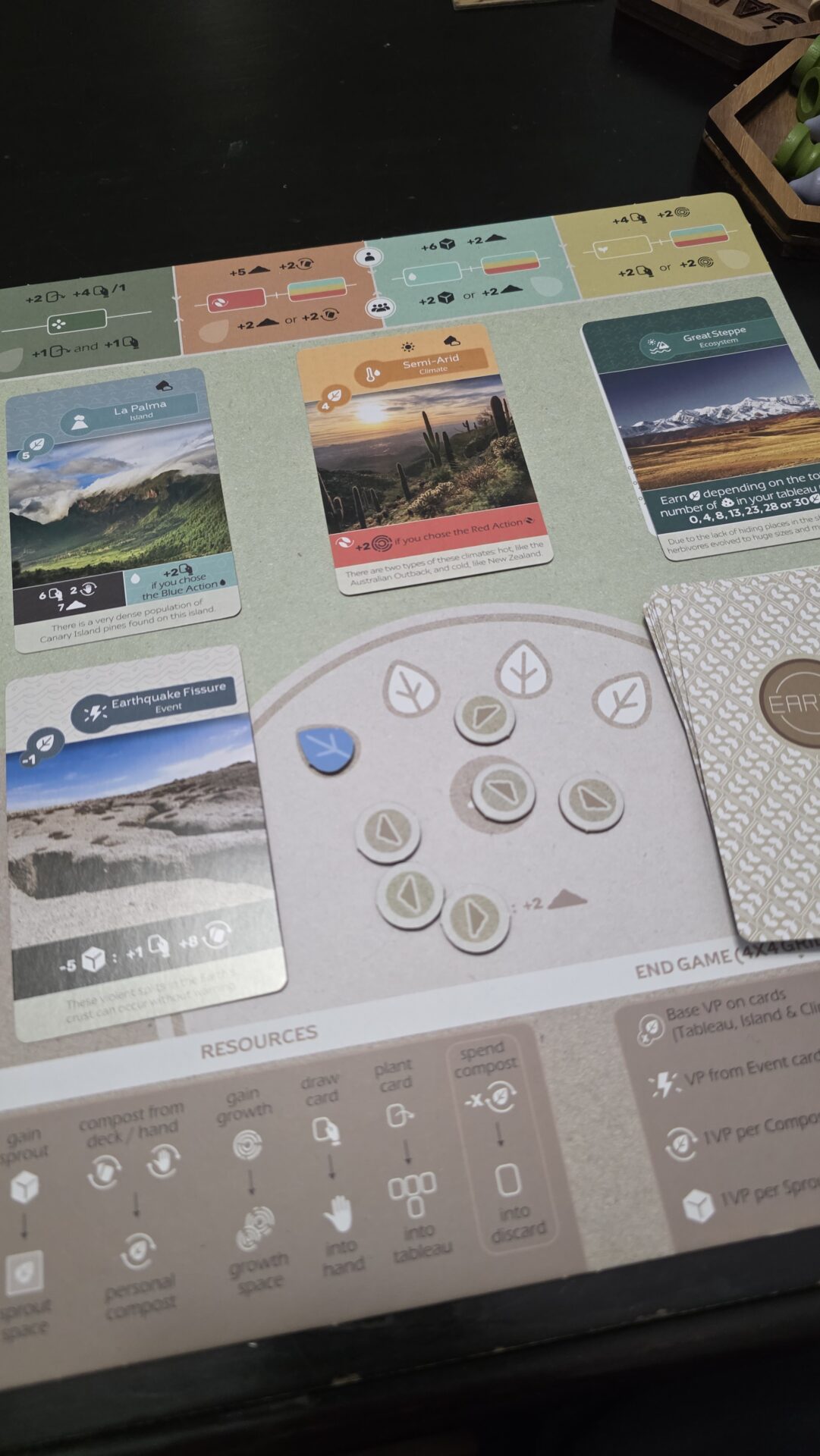
Setup & Gameplay
Setting up a game of Earth should only ever take a few minutes though shuffling this many cards can sometimes feel like a chore. After everything is shuffled, players should put together the Fauna Board first, by choosing four random Fauna Cards and placing them on the left-hand side of the board. Next, grab two random Ecosystem Cards and put them on the right side. While you have the Ecosystem Cards out, go ahead and toss one to each player for their individual Ecosystem Card. Next up, grab the Island Cards and the Climate Cards, giving one of each to all players.
Players can now choose which side of the Island, Climate, and Ecosystem Cards they’d like to use on their personal board. Players should definitely focus on their Island Card choice as this is going to grant the player their starting resources and starting card, and this can greatly impact the rest of the game. Once the sides are chosen, players will collect the things listed in the black box on the Island Card. This is usually a certain amount of Soil, as well as how many Earth Cards they’ll start with, and how many of these they need to Compost if necessary. Put all the components in piles around the table and the game is ready to start!
The main thing to understand about a turn in Earth is that no matter what Action Space you choose to use, your opponent(s) will also benefit in some way related to that action. If you’ve ever played Race for the Galaxy or Terraforming Mars: Ares Expedition you’ll have an understanding of the basics of how this all works. The Active Player will place the Active Player Token above one of the four Action Spaces on their player board and trigger the top action line while opponents trigger the bottom row. After each player has taken the action, they can then activate all cards in their tableau that match the color on the Action Space. These cards must be activated left to right, top to bottom. Don’t worry about that last part, we’ll get into more of that when we discuss the tableau but first let’s make sure we understand each action.
- Planting (Green Action) – the Active Player can Plant two cards from their hand. This means they can pay the card’s cost in Soil and place these two cards into the 4×4 grid tableau. Note that all cards must be placed adjacent to previously placed cards, either orthogonally or diagonally. They then can draw four Earth Cards from the pile and choose to keep one.
- Opponents are allowed to Plant one card and then draw one card to add to their hand
- Composting (Red Action) – the Active Player can gain five Soil from the supply and then draw two cards from the draw pile and place them into their Compost without looking at them.
- Opponents choose between gaining two Soils or Composting two cards from the draw pile
- Watering (Blue Action) – the Active Player gains six Sprouts and immediately places them on Flora Cards with empty Sprout spaces. They can then gain two Soil from the supply.
- Opponents choose between gaining two Sprout cubes or gaining two Soil from the supply
- Growing (Yellow Action) – the Active Player gains four Earth Cards into their hand and also earns up to two Growth pieces on any of their Flora Cards that have room. Players will see a number on the card next to the Growth symbol which tells them how many Growth pieces are allowed to be placed there. The player will stack Trunk pieces until they reach the maximum number and this last piece will be a Canopy piece.
- Opponents can choose between drawing two Earth Cards or gaining two Growth Pieces
As I mentioned earlier, after the players carry out the action, they will then look at the colors listed on the Action Space and can activate any cards in their tableau that match this color. The cards in the player’s tableaus will typically have a colored ribbon near the bottom, listing what happens when the card is activated. Remember though, that each card can only be activated once per turn and the player must move left to right, top to bottom, so choosing the right placement of cards in the tableau is important. It probably doesn’t need to be said, but once the card is placed, it can’t move within the tableau. Once all players are done, the Active Player Token moves to the next player and another round is performed. Play continues until someone has completed their 4×4 grid, whereas each other player gets a final turn before scoring takes place.
Speaking of scoring, what the heck is the point of even putting these cards down and triggering the actions? Well, glad you asked! Way back in the setup section, I mentioned both Fauna Cards and Ecosystem Cards. These types of cards act as objectives that players will want their tableau to meet. The four Fauna Cards offer up some competition in the game as players are vying to meet the objective earlier than all other players. The earlier you can claim the objective, the more points you will be awarded. The cards come with a variety of objectives but some include gaining a certain amount of cards in a tableau that all are worth three points or below, having three or more Flora Cards in the tableau with animal names, or having six or more cards that each have two Habitat Icons.
Of the Ecosystem Cards placed during setup, the two put on the Fauna Board are available for all players to interact with. These typically give an end-game scoring condition such as four points for every mushroom type Flora Card in a continuous diagonal line. Each player also has their individual Ecosystem Card on their player board that only they get to score at the end of the game.
Outside of these objectives, many of the components that players have been collecting will end up in a point salad. These include points for all Sprouts on cards, points for completed Growth Tokens (or less points for incomplete ones), points for the cards in your Composting Pile, and then even points for the cards themselves, including your starting Island and Climate Cards.
General Thoughts
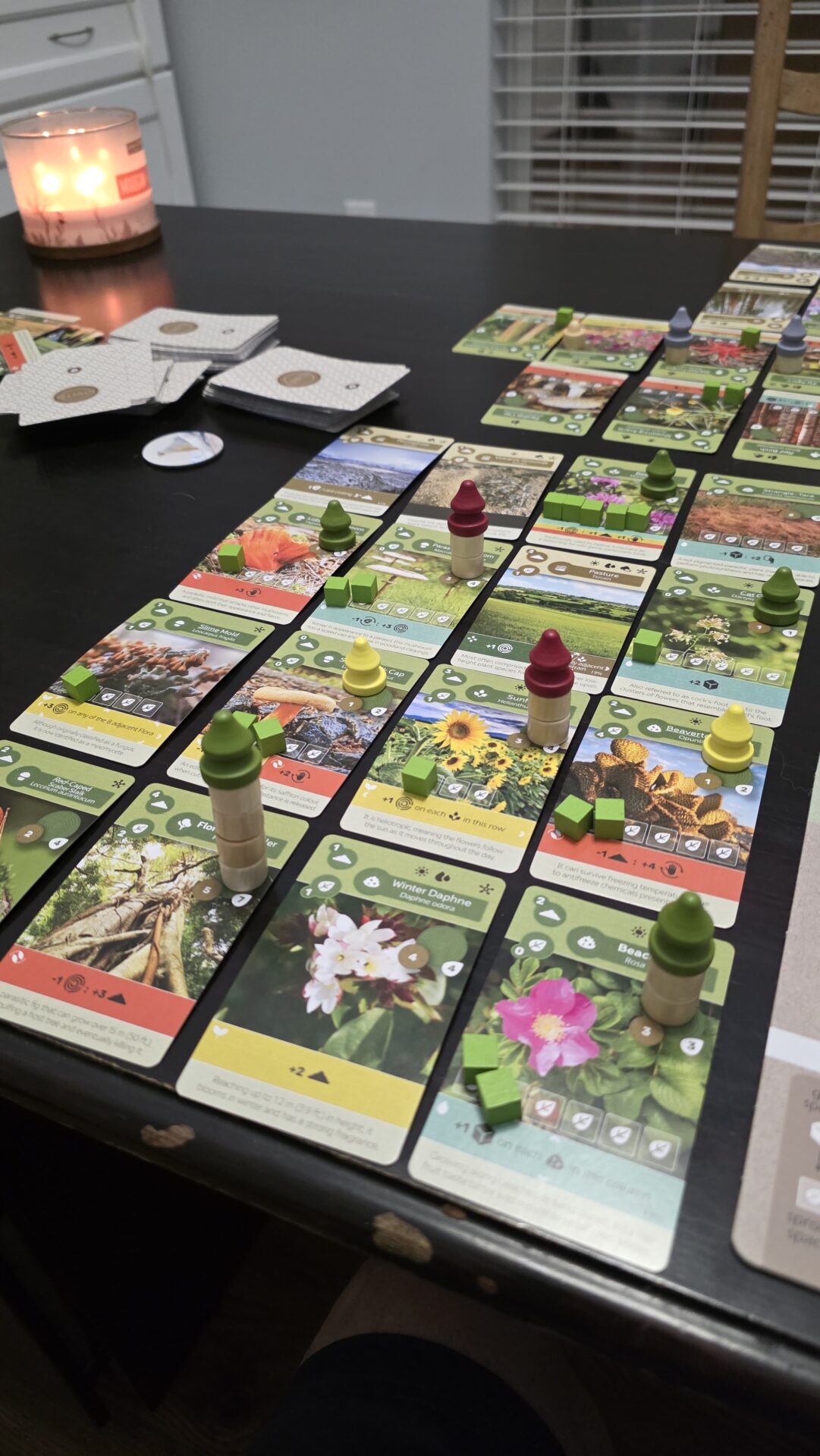
I was sort of worried when I picked up Earth that it wasn’t going to differentiate itself enough from the other tableau builders I own but for me, that has not been the case. I absolutely love the fact that everyone is getting to take actions on every turn, so any downtime is negligible. While there isn’t a ton of interaction between players, it does help to watch what your opponents are doing so that you don’t trigger an action that will help them more than it helps you. I also enjoy the fact that players are “racing” to meet the Fauna Card requirements as this heightens the pace to get certain things done during the game.
It is worth mentioning for some that the activation of cards is going to result in a lot of trading cubes for chits and then turning these chits into Growth Pieces and then possibly back to cubes and rinse and repeat. If you’re not a fan of this type of “engine builder” then you might not enjoy Earth as it contains a lot of it. But for me, I get a kick out of chaining combinations together to turn a small amount of something into something much bigger, even if the result is just a pile of cubes.
I also really enjoy that a lot of the objectives are spatially related, meaning that not only do you need to Plant certain cards into your tableau, but sometimes they have to actually be placed in specific ways, such as making sure that no column has any repeated colors. Outside of some abstract games, not many games in my collection contain this sort of spatial element and I appreciate it here.
Solo Mode Thoughts
As many readers might know, I typically pick up games that are going to have a dedicated solo mode, or at least a variant posted on BoardGameGeek that people seem to enjoy. The dedicated solo mode for Earth definitely helped me decide to buy it even though there is a wide array of opinions on it out there. The solo opponent is ran by a deck of six cards and plays similarly to a real opponent in that it gets a benefit on your turn, based on your action, as well as generates an action from its next drawn card, which gives you an action too.
The game does feel slightly different in that it is much more of a race but I feel that the player has a lot less autonomy on how to affect it. For example, the first drawn card for the AI could allow it to already claim the top score on a Fauna Card. This is a major bummer when it happens and doesn’t simulate a real opponent at all as I have no clue how anyone would ever be able to do this in a real game. The solo game feels very tight and gives the player no wiggle room. If you’re not using every turn as efficiently as possible, you’re going to lose.
For some, this might scratch their itch for a “min/max” type puzzle but others are going to be turned off quickly by the way the solo mode plays out.
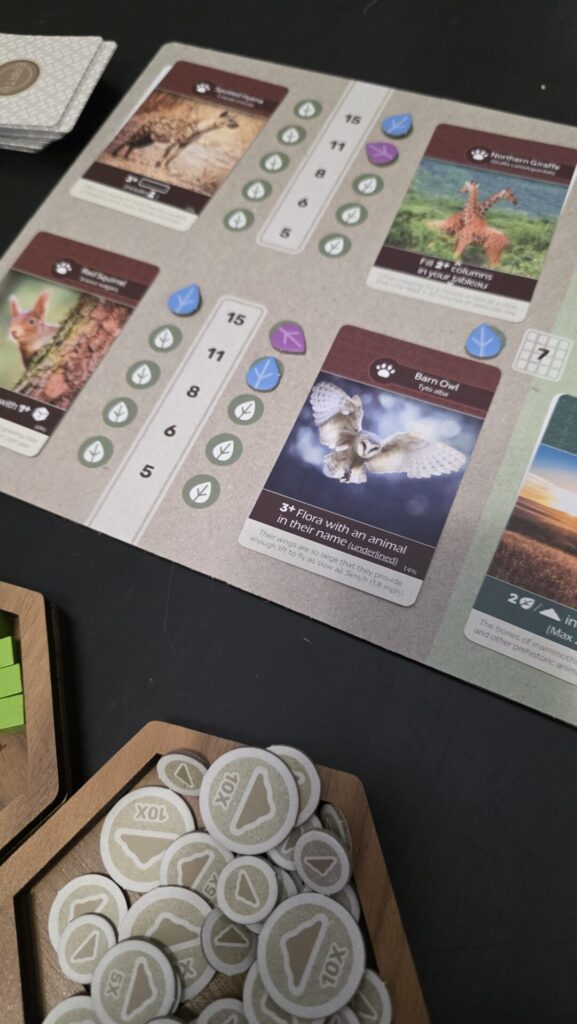
Conclusion
To tell you how much I enjoy the game, I’m doing a 12×12 challenge this year (playing 12 games 12 times each) and Earth was actually the first game of my whole collection to reach the 12 plays mark. Anyone into modern board games is going to at least know the name Earth from the myriad awards it ran when it was first released. While I don’t think the game is necessarily doing anything ground breaking, I do think that it does everything really well. For new gamers, I think the inconsequential downtime will be a hit while experienced gamers will continue to return to the game to squeak out every last point that they can.
Rating
Ratings are based on 5 main criteria: rulebook, setup, components, art & graphic design, and gameplay. The first 4 criteria are rated 1 to 5 and the gameplay is rated 1 to 10. These scores culminate in an “overall satisfaction” score that is rated from 1 to 10. If the reviewed game has both a solo and multiplayer mode, I have assigned scores separately to give context to which mode we enjoy more.
Links
